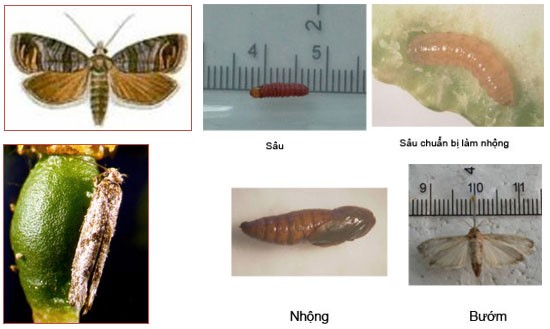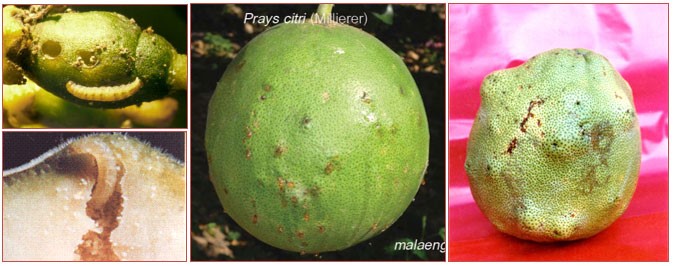|
CITRUS FRUIT RIND BORER (PRAYS CITRI)
21/06/2023
CITRUS FRUIT RIND BORER (PRAYS CITRI) a. Morphological characteristics: - The adult caterpillars is a very small butterfly with a body length of 4-5mm, a wingspan of 8-10mm, a light gray-brown color. - Young worms are green, full of strength, 5- 6mm long. - Very small spherical eggs. - The pupa is brown, 4-5mm long.
b. Biological characteristics and harmful effects: - Butterflies lay eggs scattered on flowers and young fruit. After hatching, the young caterpillars bore into the young peel and feed on the soft tissue, causing the pods to swell into a hollow cavity. - When having full of strength, the young caterpillars punch holes to come out, release silk to create a thin cocoon on the outside of the fruit peel or on the leaves to pupate. - The life cycle is about 15-25 days, in which the egg time is 2-5 days, the larva is 8-12 days, the pupa is 3-6 days, and the butterfly lays eggs 2-3 days. - Fruit rind borer mainly damages fruit, especially on grapefruit, although it also attacks on oranges, tangerines and lemons. - Fruit borers attack when the fruit is very small, the bore has created lumps and lumps on the fruit, if it is severe, the fruit will fall. - If the worm attacks at a later stage, the fruit will still develop normally but will be deformed with many large, ugly lumps, making the fruit no longer of commercial value, although the quality of the fruit is not. affected because the worm eats only the rind and does not bore into the pulp of citrus.
Preventive measures: - Monitor and detect new symptoms of harmful pests on fruit when the tree has just set fruit. - Collect the infected fruit (on the tree and fall to the ground), bury it deep in the ground to kill larvae still present in the fruit. To kill the larvae more thoroughly, soak the infected fruit in a bucket of lime water mixed with 1% concentration for 24 hours. - In frequently infected areas, you can use chemical products such as: Secsaigon 25EC, Sairifos 585EC, Lancer 50SP, ... to prevent and control when the tree has just produced young fruit, it can be sprayed 2 times in a row, each time separated from each other. 7-10 days. - Monitoring to detect the presence of pupae on leaves, when the pupae appear profusely, 5-7 days later, they can be treated with products to prevent the outbreak of the next generation. - In some countries around the world, Pheromone has been used to predict fruit borer very effectively. |
To prevent, in addition to plowing and burying weed seeds, collecting weed stalks and stumps left after tilling the land to burn, not letting weeds produce seeds in production fields, etc., the use of chemical products is still a measure. optimal because of its ability to thoroughly kill weeds, reduce labor and take advantage of more time than manual weeding.
Miner has the scientific name Phyllocnistis citrella Staint., family Phyllocnistidae, order Lepidoptera. The miner occurs in many countries in the tropics and subtropics. The main host of the miner is the citrus family - Rutaceae. In addition, the miner also attacks mangosteen and some other plants.
Adult is a small planthopper, with a body 2-3 mm long, the whole body is ash gray, slightly greenish, the wings are opaque with many small brown spots.Eggs are oval, 0.3 mm long, have a pointed end and are attached directly to the leaf surface, leaf axils.
Green bugs specialize in the fruit of citrus groups (oranges, tangerines, lemons, grapefruits, kumquats...), some people call them orange bugs, or orange suckers. Their scientific name is Rhynchocoris poseidon or Rhynchocoris humeralis.
In Vietnam, yellow leaf curl disease is very common on papaya trees, especially the disease is often severe in areas of high and continuous planting, areas with hot and arid climates. The disease has significantly reduced the yield and quality of papaya. Gardens that are infected early when the plants are young may not yield. However, up to now, many gardeners still do not know the cause and how to fix it.
Spider mites are common pests on citrus trees, especially in hot and dry climates that are suitable for spiders to grow and cause severe damage.The group of harmful spiders is usually very small in size, unlike the natural enemy spiders.
This group includes species that are generally very small in size, causing damage by sucking plant sap (on leaves, fruits, branches, stems).
There are many species of mealybugs present on the group of Oranges,Tangerines,Grapefruits and Lemons (Citrus), which can be divided into 2 groups:
+ Group of sticky mealybugs with common varieties such as Lepidosaphes, Aonidiella, Coccus and Saissetia.
+ Group of flower mealybugs with common genera and species such as Pseudococcus, Planococcus and Icerya purchasi.
Dry branches and berries disease often appear to be common damage on coffee gardens during the rainy season. The disease causes death of branchs, dry fruit, severely affects the canopy structure and coffee yield if not paid attention to prevention.
Pink disease commonly causes diseases on rubber plantations in the rainy season, especially on garden from 4-8 years old. This year, rubber has to go through a period of severe drought, weakening the tree, so now in tnshe rainy season it is easy to get infected. Therefore, it is necessary to pay attention to good management to avoid affecting the garden.
In recent years, the area of citrus has been expanded because it is a fruit tree with high economic efficiency. However, in order to sell at a high price, not only in quality but consumers also require the external beauty of the fruit, so pest management on citrus is a matter of great concern to farmers. The hot season is a favorable condition for thrips to develop and cause damage, affecting the commercial value of fruit.
- Headquarters
- SAIGON PLANT PROTECTION JOINT STOCK COMPANY
- RQ 1, Nguyen Van Quy St., Tan Thuan Ward, HCM City
- Tax code: 0300632232
- Tel: (028) 38 733 295 - 38 732 077
- Fax: (028) 38 733 003 - 38 733 391
- Website: www.spchcmc.vn - Email: info@spchcmc.vn
- SAIGON PLANT PROTECTION COMPANY
- SAIGON PLANT PROTECTION JOINT STOCK ENTERPRISE
- Lot C1-C3 Hiep Phuoc Industrial Park, Hiep Phuoc Commune, HCM City
- Tel: (028) 3873 4089 - Fax: (028) 3873 4086
- Affiliated Unit
-
- Quick Links
- Home
- About us
- Career Opportunities













